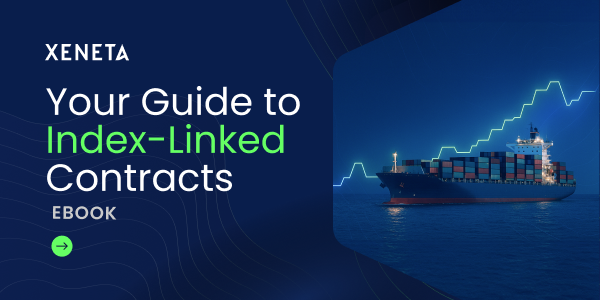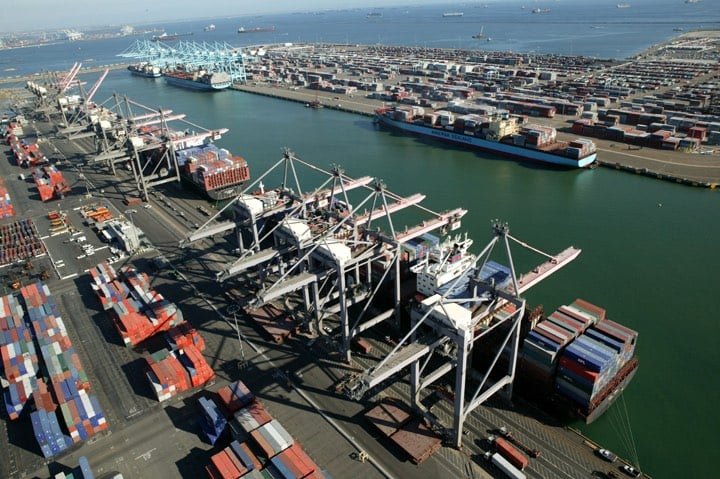Escalation of the Red Sea crisis in December 2023 is an important waypoint for ocean container shipping because it caused average spot rates to spike dramatically on major fronthaul trades without ever returning to the previous level… but is that set to change?
Average spot rates from Far East to US West Coast have been generally trending downwards since the post-Red Sea market peak in July 2024 and plummeted a further 59% since 1 June this year to reach the lowest level since 31 December 2023, just as the crisis was taking hold.
This raises a timely question - will freight rates continue to fall and, if so, will they drop to pre-Red Sea crisis levels?

If rates are falling, why did they spike in the first place?
The Transpacific to US West Coast is not operationally impacted by the Red Sea crisis because it does not transit the Suez Canal. Yet, during the post-Red Sea crisis market spike in 2024, freight rates increased to a greater extent to the US West Coast compared to the US East Coast – a trade which is operationally impacted by the Suez Canal (+388% and +298% respectively between 1 December 2023 and 1 July 2024).
The answer to this contradiction is found in capacity offered by carriers. As the majority of ships began to avoid the Red Sea and sail around the Cape of Good Hope in early 2024, the longer sailing distance absorbed shipping capacity. Carriers reacted by shifting capacity off trades such as the Transpacific and onto the operationally-impacted trades.

In March 2024, offered capacity on the Transpacific fell to the lowest level since July 2023 at 218 000 TEU (20ft equivalent container).
This drop in offered capacity coincided with shippers frontloading imports to protect supply chains against the Red Sea volatility and sent average spot rates skywards during April, May and June 2023. Carriers then responded to the spiraling rates by bringing capacity back to the Transpacific, resulting in average spot rates peaking in early July.
It is no coincidence that average spot rates peaked at USD 8023 on 5 July 2024 just as the four-week rolling average for capacity on this trade also peaked at 341 000 TEU on 8 July (this remains the all-time-record offered capacity on this trade).
In very simple terms, the cost of ocean container shipping is almost always a matter of supply and demand.
Why are freight rates falling?
We are now seeing the other side of the coin in terms of capacity. When container shipping demand fell off a cliff in the aftermath of Trump’s ‘Liberation Day’ tariffs in early April this year, offered capacity on the Transpacific trade fell to 241 000 TEU in the week of May 12.
It should be noted that even the 241 000 TEU was more than the capacity offered on this trade in March 2024.
When Trump subsequently announced the 90-day lowering of tariffs for Chinese goods on 12 May, this sparked a cargo rush – but carriers had reduced offered capacity post-Liberation Day in an attempt to keep rates elevated.
In much the same way as the spike in 2024, the rush in cargo following the 90-day lowering of tariffs coincided with lower offered capacity, causing average spot rates to increase 75% on 1 June from 31 May.
Data in the Xeneta platform shows carriers responded to the June freight rate spike by rushing capacity back to the Transpacific – but it takes times to redeploy container ships. By 30 June, the four-week rolling average for offered capacity reached 335 000 TEU – second only to March 2024 as the all-time record on this trade.
However, the cargo rush following the 90-day lowering of tariffs was only ever going to be short-lived. Now inventories have been built up, shippers are taking their foot off the gas. While demand may be easing, offered capacity remains high and we are seeing the result of this in plummeting average spot rates since 1 June.
Will average spot rates fall to pre-Red Sea crisis levels
As this blog demonstrates, the answer to this question depends very much on carriers’ ability to manage capacity.
Average spot rates currently stand at USD 2274 per FEU (40ft container) on the Transpacific trade. This is much closer to the pre-Red Sea crisis USD 1 643 per FEU on 1 December 2023 than it is to the post-Red Sea crisis market peak of USD 8023 per FEU on 5 July last year.
If carriers do not lower offered capacity from the current level of 337 000 TEU, then there is every chance average spot rates will fall to pre-Red Sea crisis levels given ocean container shipping demand is likely to remain subdued for the remainder of the year.
However, carriers will not sit back and watch freight rates plummet and we have seen numerous examples of successful capacity management in the past.
This also raises the potential knock-on impact across the world’s ocean container shipping trades. If carriers prioritize protecting rates on the vitally-important Transpacific trade, they may be successful in keeping rates above pre-Red Sea crisis levels. However, if that capacity is redeployed on other trades – such as the Transatlantic or Far East to South America East Coast – then freight rates will likely tumble here instead.
The overcapacity challenge
Lowering capacity to keep spot rates elevated is simple in theory but difficult in practice, especially when we look at the growth in the global ocean container shipping fleet in recent years.

From an index baseline of 100 in 2019, the global shipping fleet size now stands at 145 points. In the same period, global container shipping demand has increased from a baseline of 100 points to just 113 points.
Even when factoring the impact of the ongoing diversions around the Cape of Good Hope using TEU-miles, demand has still only increased to 130 points, far shy of the supply growth.
Note: TEU-miles is Xeneta’s measurement of demand when factoring the volume of containers and the distance they travel.
Carriers face an immense challenge in preventing freight rates from falling further against this backdrop of significant overcapacity in the global fleet.
It is unlikely the Red Sea will open up to container shipping at large during 2025, but in this scenario the challenge facing carriers in managing capacity would increase exponentially.
How can shippers play their hand?
It should be pointed out any financial savings a shipper makes through lower freight rates pales in comparison to the overall increase in import costs due to the US tariffs.
However, putting the tariffs to one side, even if spot rates don’t fall all the way down to pre-Red Sea crisis levels, shippers are in a far better negotiating position than they were in July last year.
A shipper may think they hold all the cards in the negotiation with carriers, but they need to play them carefully.
When average spot rates were USD 1 643 per FEU on 1 December 2023, similar conversations were taking place as shippers tried to target the lowest contract rate possible. Then the Red Sea crisis hit and these contracted rates were torn up and shippers were forced to pay a premium if they wanted to move their goods.
Given the current geo-political climate, it would be unwise to bet against another major supply chain shock on the horizon.
Long term contract market to fall to pre-Red Sea crisis level
This blog demonstrates the importance of understanding freight rates and capacity movements at a regional, trade and port level. If you ship from the Far East to South America East Coast, this trade is not directly impacted by tariffs or the Red Sea conflict – yet the rates you pay are very much influenced by both factors.
It is also essential to understand the dynamics between the spot rate market and the long term contract market.

Xeneta data shows average long term contract rates on the Transpacific trade have also been declining and are now up just 5% compared to pre-Red Sea crisis on 1 December 2023.
Peter Sand, Xeneta Chief Analyst, forecasts the long term average rate on this trade to drop to pre-Red Sea Crisis levels in the coming months in what would be a significant marker.
However, he also believes long term rates dropping to pre-Red Sea crisis level would likely see a reaction from carriers facing a loss-making position through even more stringent capacity management measures.
This capacity management and potential for a slight recovery in demand may put upward pressure on long term rates again towards the end of year, which could be key for carriers during negotiations for new contracts in 2026.
Shippers must understand the challenges facing carriers when entering negotiations – particularly around overcapacity - and use this data to push back against surcharges.
Index-linked contracts are also a mechanism that ensures the rate a shipper pays tracks the market against agreed thresholds. During a market spike it ensures your goods are moved while also protecting against leaving money on the table in a falling market.
%201.png)



.png?width=1500&height=450&name=Newsletter_BlogCTA%20(1).png)
.png?width=387&name=image%20(45).png)

